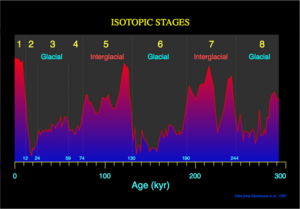Milankovitch cycles
Milankovitch cycles are cycles in the Earth's orbit that effect the amount of solar radiation striking the Earth at different times of the year. They are named after Milutin Milanković. These cycles include the precession, eccentricity, and obliquity of Earth's orbit. All three processes occurring simultaneously produce 100,000 year ice age cycles.
Main Orbital Forces
The precession is Earth's wobble caused by our daily rotation while orbiting the Sun. It is the same physics as a top's wobble: the Earth's axis currently points towards the star Polaris, but after 21,000 years our axis will have made a complete circle. At 10,500 years our North will be 180 degrees away from where it points now, essentially South from the current perspective. The study of paleomagnetism has demonstrated that the Earth's magnetic field varies in both orientation and intensity through time. The positions of magnetic north and magnetic south become interchanged. "Evidence from high-sedimentation-rate South Atlantic deep-sea cores indicates that global and Southern Ocean carbon budget shifts preceded thermohaline circulation changes during the last ice age initiation and termination and that these were preceded by ice-sheet growth and retreat, respectively." [1]
Magnetochronology is the study of geomagnetic reversals. "The last swing of the VGP (virtual geomagnetic pole) from the southern hemisphere to the northern hemisphere in the Brunhes-Matuyama geomagnetic reversal took only 38 yr." [2] Ocean sediments are used for chronostratigraphy as well. This is time related to layers of rock, in this case ocean rocks. The oxygen isotopes from the rocks can be analyzed and correlated to temperature of Earth.
When you make an observation of the direction of the geometric field, to calculate the pole position, and this is done from only one location, then it is called a VGP. Ten or more site-mean VGPs should be used to calculate a paleomagnetic pole, this number would provide a reasonable average.[3] For the year 1980, the north geomagnetic pole was located at approximately 79°N, 289°E in the Canadian Arctic Islands.
Notes
- ↑ Alexander M. Piotrowski, Steven L. Goldstein, Sidney R. Hemming, and Richard G. Fairbanks Science 25 March 2005 307: 1933-1938 [DOI: 10.1126/science.1104883]
- ↑ Okada, M., Niitsuma, N., " Detailed paleomagnetic records during the Brunhes-Matuyama geomagnetic reversal, and a direct determination of depth lag for magnetization in marine sediments" Physics of the Earth and Planetary Interiors, Volume 56, Issue 1-2, p. 133-150. 1989.
- ↑ http://faculty.up.edu/butler/books/chap07.pdf

